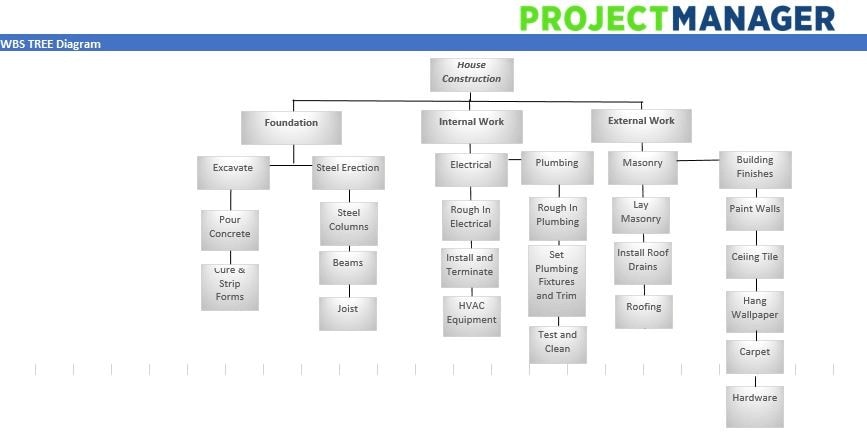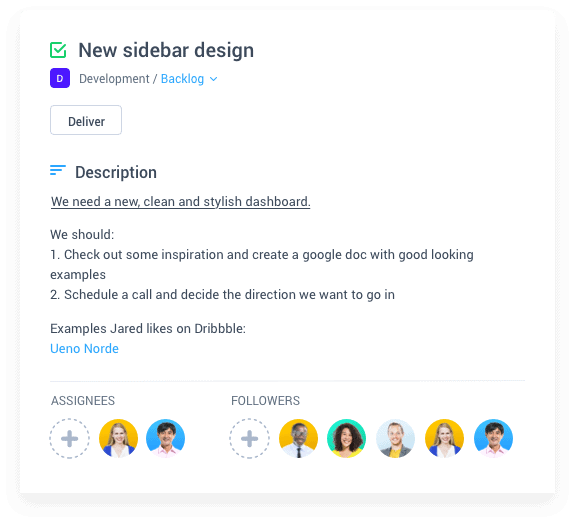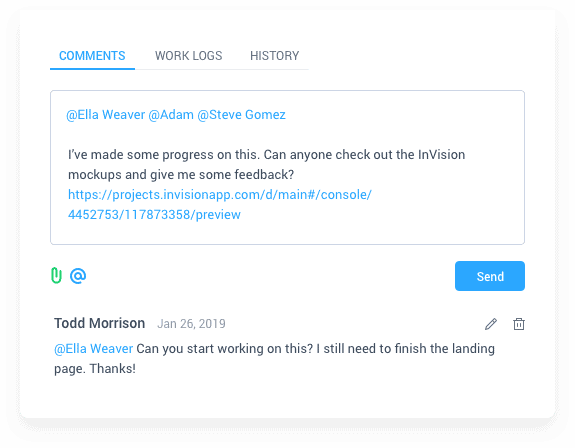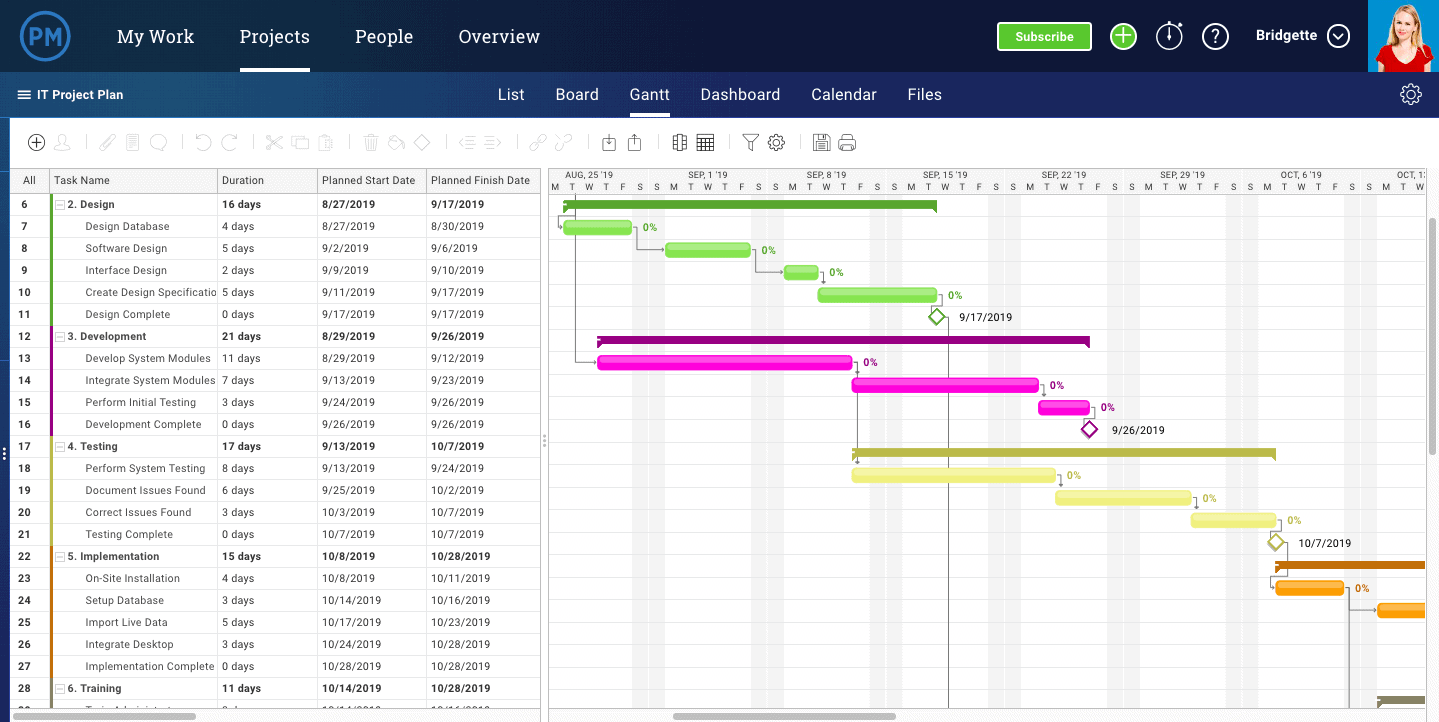We’ve all heard that familiar phrase, “Don’t bite off more than you can chew.”
This idea is never more true than when starting a new project. For project managers, it’s tempting to start with big, lofty plans for what you will accomplish. However, you’re left with project delays, exceeded budgets, and general chaos without proper planning.
Using a work breakdown structure in project management (WBS), you can organize and create a system to roll out a new project.
This will make your life easier and keep your team steadily moving toward your (attainable) end goal.
In this article, we’ll look at:
- What a work breakdown structure (WBS) is
- The benefits of this project management approach
- How it compares to other methods
- How you can get started right now
- Best practices for implementation
- Work breakdown structure example
- Work breakdown structure template
Let’s dive in.
Boost your team’s efficiency with Hubstaff's productivity tools
What exactly is a work breakdown structure?
A work breakdown structure in project management is a hierarchical structure of project activity.
In simple terms, it’s a list of what needs to be done within a project. It breaks down the tasks into clear steps and displays them within a work breakdown structure chart or other visible representation so the team can easily see each project step. According to the Project Management Institute, a Work Breakdown Structure (WBS) is a product-oriented “family tree” of project components that organizes and defines the total scope of the project.
WBS elements include project phases, deliverables, work packages, milestones, and time frames.

WBS project management benefits
You may think creating a project plan is sufficient, and that a work breakdown structure is redundant.
While proper project planning is vital, so is a work breakdown structure. Here are a few benefits.
Tasks are completed
Although you have a plan, smaller tasks can get overlooked once the project rolls along.
WBS project management breaks out each of these tasks visually. The team can see what steps must be completed and in what order and create a parent task for large projects.
This ensures nothing is skipped or forgotten in the process. And on the flip side, no unnecessary steps are added — everything is clearly outlined from the beginning.
Keeps team members accountable
Just like a breakdown structure keeps tasks organized, it also keeps project team members organized.
A WBS shows the entire team what tasks need to be completed and in what order.If you’re using a project management tool like Hubstaff Tasks, you can easily assign these tasks to each person or multiple people simultaneously.

This way, nothing is missed. You can easily see what’s on everyone’s plate and follow up with the team members responsible if the task misses its deadline.
Fosters communication
Since all tasks are visible to the entire team, it’s easy for team members to communicate with one another.
For example, if work needs to be completed on one task before another team member can begin their part, it’s easy to find the holdup.
This open communication brings unforeseen shifts in an established project management lifecycle to the forefront.
The more the team communicates throughout the process, the smoother the project will run.

Provides structure
Work breakdown structures take a project scope and put it to paper.
Since all tasks are accounted for and organized, it provides a clear path for the team.
Although you should anticipate unexpected changes during a project, creating a detailed and defined WBS can make surprises less destructive for your team.
Helps with budgeting
By breaking a project into small sections as a WBS does, it’s easier to estimate the costs involved.
Since each task is assigned a team member, you’ll quickly see how many team members you need. This helps estimate the staff and budget needed.
By looking at the number of tasks, it’s easier to estimate a project deadline based on what needs to be completed.
Carries out the project plan
If you think about it, a project plan is an outline of a project, but project success really stems from the work breakdown structure.
Your structure is the lifeblood of a project. It helps with everything from resource planning to schedule planning to time estimations.
WBS vs. project plan vs. project schedule
You now know why a WBS is a vital step in project management.
However, you might still wonder how it works with other project management components, such as a project schedule or plan.
As we discussed previously, a WBS takes the tasks needed to be completed from a project plan and breaks these out.
It focuses purely on the project management deliverables. It doesn’t include a time component, predecessors, or dependencies.

A project schedule assigns time constraints to each task and shows dependencies. It also establishes a timeline for the project.
Altogether, your process might look something like this:
- Create your project plan
- Create a work breakdown structure
- Then, you will use these two to create a project schedule.
Creating a WBS before a project schedule will provide an uncluttered view of the tasks before dates and team members are assigned. This will help ensure you have everything accounted for.
How to create a work breakdown structure
Every WBS has a few components. Although, there are different formats you can use depending on what works best for your project and company.
No matter which format you choose, the overall structure should include the following parts.
1. Establish project objective
Take a look at your project plan and use the project objective you’ve established. This should go at the top of your work breakdown structure.
2. Break out the tasks and subtasks
Next, you want to break down the tasks into smaller and smaller tasks.
The point is to identify project deliverables and focus on those. For example, you may have ten large tasks, but underneath each, you may have 20 subtasks that need to be completed to achieve the more significant task.
The goal is to break out these tasks to meet the project objective better.
One way to do this is with a Kanban board. This project management framework allows you to make each subtask its own card, with due dates, descriptions, and assigned team members. These cards belong to a larger project, which you can view simultaneously as one board.

3. Assign project phases
Depending on how large or complex your project is, you’ll want to establish phases of the project.
This will make it easier to create a project timeline from your WBS.
For example, your phases might be:
- Initiation
- Planning
- Execution
- Results
WBS best practices
Now, some words of advice for making your WBS the best possible working document. Here are some WBS best practices to keep in mind.
Think about tasks carefully
You’ll want to think about what work needs to be completed.
Use your WBS as a way to organize the most critical tasks. Remove any tasks that seem unnecessary or unrelated.
Also, look at your main tasks. Can each subtask fully meet the needs of the main tasks?
List tasks once
If you have a complex project, it’s easy to start listing a bunch of tasks without looking at it from a high level.
Step back and make sure you are only listing each task once.
You don’t want to clutter your process or confuse your team members with two people doing the same or redundant work.
Focus on deliverables
The point of a WBS is to focus on outcomes and not the actions needed to meet those deliverables.
For example, if you were building a car, you would list the tire pressure control system and not create proper tire pressure in each tire.
Don’t go too small
Think attainable and realistic when creating subtasks.
In other words, subtasks should take at most 80 hours to complete or ten days.
A work package should take no longer than a month to complete. When you go through your project tasks, make sure they are doable in a reasonable timeframe and do not break out too much.
Trying to take on too much or too little will lead to incomplete or subpar projects.
Create project phases
Projects range in size and complexity.
However, if you create at least three project phases, you will better organize the project and the team.
For example, these phases may be called the initiation phase, planning stage, and execution phase.
Assign team members
Once you have created a work breakdown structure, assign tasks and subtasks to each team member.
There should be no overlap or missed tasks; one team member should be accountable for the main tasks. That person takes ownership and can check to see if all subtasks are completed on time.
Work breakdown structure templates for project management
There are several work breakdown structure options to get you started. Choose the one that works best for keeping your project team on task and organized.
Download your own WBS structure templates
Fill out the form below to get your WBS structure templates.
Tree structure
The tree structure is a more visual option. As the name suggests, you start with a primary objective and branch out to three or four sub-objectives to meet the overall project goal.
Then, you create more and more subtasks to complete each sub-objective. This WBS can be created in Microsoft Word or a chart design program.
Outline view
The outline view is just what it sounds like.
You start with the main objective, list sub-objectives, and then list tasks to be completed in order under each project phase.
This is a good option if you need to make changes throughout the project. Items can easily be shifted around. The outline view can be created in Microsoft Word.
Hierarchical structure
The hierarchical structure is much like the outline view but doesn’t include indentation.
This view may be more challenging to read, but it makes more sense if you have a complex project.
Indentation in the outline view takes up space and requires larger project management documents when you have multiple project levels.
This hierarchical structure can be created in Microsoft Excel.
Tabular view
The tabular view is another work breakdown structure in project management that can be created in Microsoft Excel.
It lists project phases in levels with level one being the project objectives, level two being the main phases, and level three being the subtasks.
Perfecting your work breakdown structure
Spending time crafting the ideal project plan and assessing the risk management in project management are critical components of any project rollout.
But don’t forget to spend time creating the ideal work breakdown structure. Not only will it help a project manager ensure the team completes all tasks on time, but you’ll uncover unforeseen issues before they derail your project.
The more you can plan and organize your project, the better the result will be for your team and the company.
Subscribe to the Hubstaff blog for more posts like this
Most popular
The Critical Role of Employee Monitoring and Workplace Security
Why do we need employee monitoring and workplace security? Companies had to adapt fast when the world shifted to remote work...
15 Ways to Use AI in the Workforce
Whether through AI-powered project management, strategic planning, or simply automating simple admin work, we’ve seen a dramatic...
The AI Productivity Panel: Lessons From Leaders on What’s Working (and What’s Not)
When I moderated this AI productivity panel, I expected a solid conversation. What I didn’t expect was the flood of real-world i...
Employee Performance Dashboards: Templates, Tools, and Best Practices
Keeping track of how your team’s really doing can be tricky. Spreadsheets pile up, one-on-ones only tell part of the story, and...
![Work Breakdown Structures in PM: Everything You Need to Know [Free Templates]](https://hubstaff.com/blog/wp-content/uploads/2020/02/Breakdown_Schedules@2x-2.jpg)




